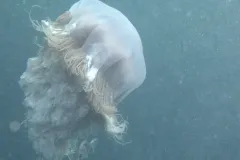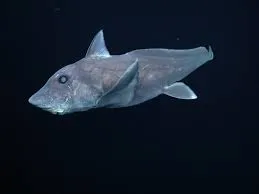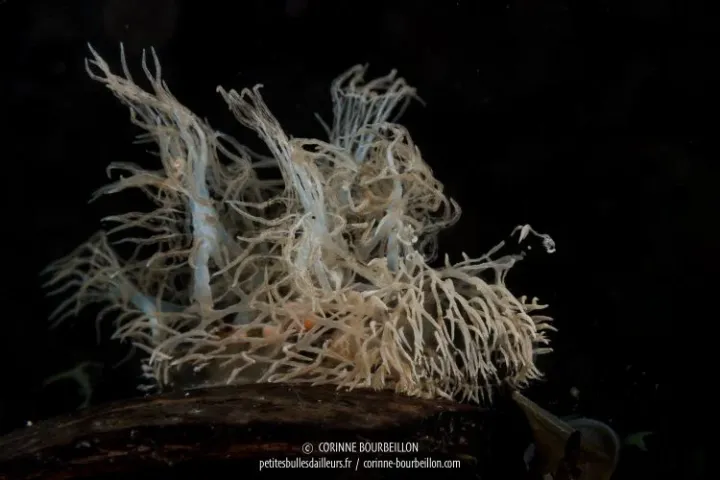Ghosts of the Ocean: Explaining Marine Life Devoid of Color

Marine animals come in every color of the rainbow, plus some beyond the colors we know. While some species show off their bright colors, camouflage, or even bioluminescence, others opt to go a less flashy route with white or transparent coloration.
In the Halloween spirit, many of these white or colorless species earned the common name “ghost.” These include the ghost octopod, ghost jellyfish, ghost sea slug, and ghost shark, which each are part of families that are typically quite colorful. Marine scientists have come up with plausible evolutionary explanations for these intriguing color differences.
I. Ghost Octopod
One ghostlike marine species is fittingly named Casper the “ghost octopod.” Octopods, also known generically as octopuses, are typically celebrated for their huge color variation, ranging from red, to purple to pitch black. Some species are also known to be able to camouflage or change color. This is made possible by tiny organs called chromatophores in their skin, which contain pigment sacs that can grow and shrink as the muscles surrounding them contract and expand.
Casper, who was first spotted off the coast of Hawaii in 2016, lacks both pigment and chromatophores. The octopod appears a shimmery white on an underwater camera.
Casper’s unique color, as well as the fact that it was observed 2.5 miles underwater, much deeper than any other octopod of its kind, make scientists wonder what this new organism is. In fact, scientists think this is not only a newly discovered species, but also probably a new genus and maybe even a new family, two levels of classification broader than a species.
One explanation for this octopod’s unique lack of color is the depths at which it lives—one individual was found over 2.5 miles underwater, much deeper than any other finless octopod relative in the incirrate group. According to Mike Vecchione, an octopod expert at NOAA and the Smithsonian National Museum of Natural History, the Casper octopod may have evolved to be colorless because creating pigments and chromatophores takes a lot of energy. In the deep sea, where animals live out of the light and visibility is incredibly low, there is no benefit to having these organs. “If you can dedicate your resources to something else by not making something you don’t need, then you’re better off,” Vecchione explained.
Casper’s strategy may be saving the octopod valuable energy that it needs to collect food and grow in a nutrient-deficient environment of the deep sea.
II. Ghost Shark
If ghosts and sharks weren’t each terrifying enough, the deep sea is home to a combination—the ghost shark. But the ghost shark isn’t technically a shark, it’s a type of cartilaginous fish called a chimaera. And of course, despite its eerie appearance, it isn’t actually a ghost.
Ghost sharks, or chimaeras, comprise at least 53 different species, which live all around the world but are most common in Australia and New Zealand. These species are cryptic, meaning that scientists cannot tell just by looking at an individual exactly which species it belongs to. Even the colors — which can range from white to purple or brown — can differ within species, making it difficult to classify these creatures on first sight. Often differences between species are internal or too small to see without a microscope or DNA test.
This cryptic coloration is typical of deep-sea species, which tend to be indistinguishable by visuals alone. This might be because they and their predators cannot see their colors, making pigmentation an accidental, and neutral, characteristic.
According to Dr. Brit Finucci, a fisheries scientist and ghost shark expert in New Zealand, the ghost shark’s pigment might be related to its diet, rather than to genetics. Much like flamingos develop their pink color from a shrimp-based diet, ghost sharks may develop color variations from differences in their own diet.
Following this explanation, as ghost shark species go deeper in and deeper in the ocean they feed upon organisms that are progressively paler which in turn impacts their own pigmentation.
III. Ghost Sea Slug
Nudibranchs, or sea slugs, are a diverse group of marine invertebrates that come in all shapes, sizes, and colors. Some are extremely brightly colored and patterned, including the famous “Spanish dancer” and “Spanish shawl”. Other species effectively blend into their environment. The ghost nudibranch Melibe colemani, for example, is entirely translucent except for lines of its digestive duct.
Nudibranchs are found all over the oceans of the world, and at a huge range, from the surface to the deep sea. The species closer to the surface tend to be more colorful, while those lower down tend to be transparent or dull, as less light gets down here.
One explanation for the bright colors of some nudibranchs is that they are aposematic, meaning that they deter predators, much like poisonous frogs use their colors to signal to predators that they’re toxic. Meanwhile, being transparent like the ghost nudibranch can help camouflage with the surroundings to hide from their predators.
But while these explanations seem logical, scientists often do not have the evidence necessary to confirm them, according to Jessica Goodheart, a scientist at the American Museum of Natural History who specializes in studying nudibranchs. The color variation could equally come from the unique diet of each nudibranch species, which varies based on location and depth.
Comparing these varied explanations, Goodheart says finding the one correct evolutionary explanation for a certain trait is difficult. “There are some things we just can’t answer because we don’t know what happened in the past. But we do our best to compare and try and evaluate what might be the most likely explanation,” she said.
IV. Ghost Jellyfish
Jellyfish anatomy consists of a bell and long, flowing tentacles, making them look much like typical depictions of ghosts. The ghost jellyfish, Cyanea nozakii, takes this to the extreme, with a milky-white mantle and a blood-red core.
According to Allen Collins, a jellyfish researcher at the Smithsonian National Museum of Natural History and NOAA, the energy cost of making pigments might be why some jellyfish have evolved to avoid being colorful. However, he cautions against this line of thinking since maintaining a translucent appearance may also require a lot of energy.
“Until someone puts forth a hypothesis and then goes to test it, we don’t know,” Collins said. “As far I can tell, there is no research on why that species is white.”
For some jellyfish colors, there are well-established evolutionary hypotheses explaining the colors we currently observe. One example is the dark red jellyfish, which is thought to have a dark red pigment around its gut to hide any bioluminescent prey inside its gut. This protects the jellyfish from being detected by predators who would otherwise be attracted by the bioluminescence. However, Collins emphasizes, this explanation hasn’t been supported by research yet.
“I think a lot of times they do start as just-so stories,” Collins said. “You say ‘maybe, but I don’t know.’ And then if you want to test it, you really have to focus in on what it is.”
Between energy preservation, camouflage, predator deterral, and diet, the ghosts of the ocean provide us with a long list of evolutionary explanations. But, as is the case with any ghost, these stories aren’t so easy to prove.





